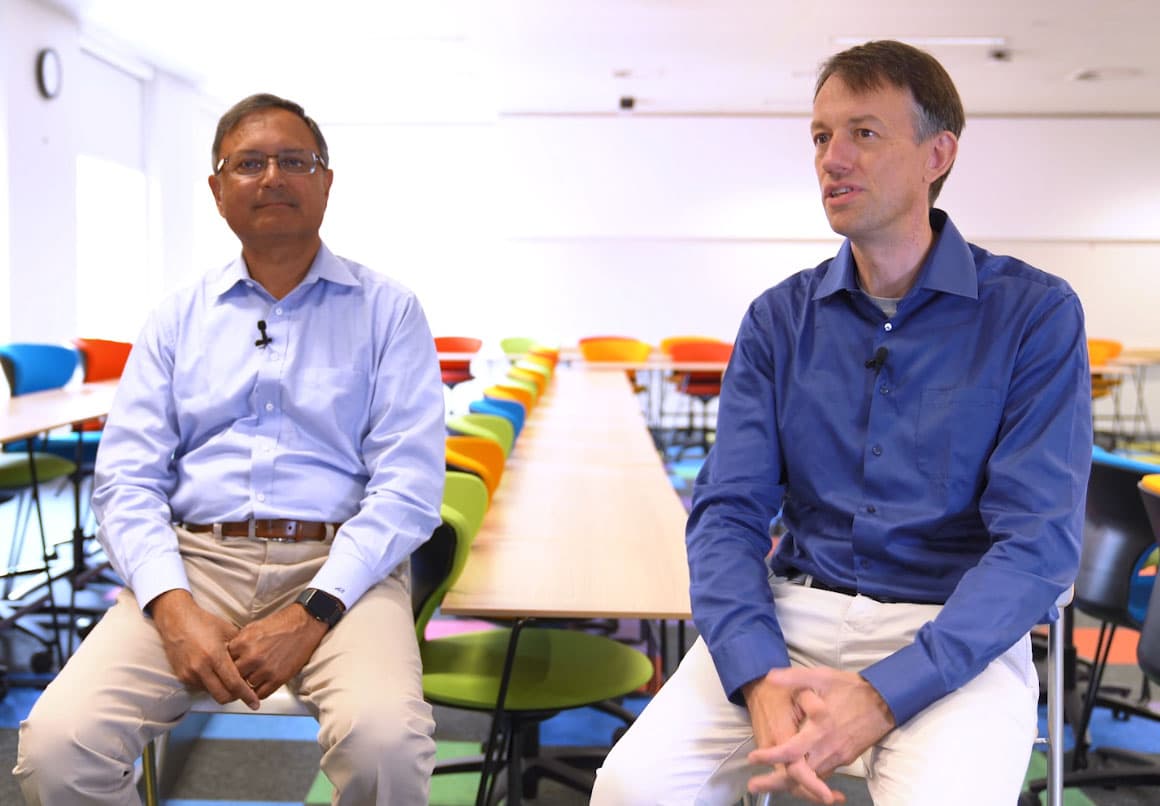How to win with digital innovation
Transform your products, processes and business models to compete successfully in a digital economy
Few people today have heard of MySpace, even though it was the leading social media platform until midway through the first decade of the 21st century, when Facebook emerged and quickly overshadowed it. The reason? Facebook capitalised on the key elements necessary for success as a digital platform - elements that MySpace had misunderstood. If only MySpace could have read the recently published book Competitive Digital Innovation - Transforming Products, Processes, and Business Models to Win in the Digital Economy by Professors Amit Basu and Steve Muylle. Here's why.
The title says it all. This is a book on competitive digital innovation. “It’s about how companies can use digital technologies to become more competitive in their chosen market space”, is how Steve sums it up. “So we look at how companies can use digital technologies to transform their market-facing business processes, their products and services, and even their scope and business model, in order to succeed in today’s increasingly digital world.”
Amit joins in: “We show that you need to understand the fundamental differences between digital and traditional business. Too often people assume that digital just means using computers to do what they were already doing. It’s not. It means harnessing those fundamental differences and digital technologies in an effective way to compete successfully.”
But isn't this just digital transformation?
You could be forgiven for thinking so. But Amit and Steve are keen to point out the difference between digital transformation and competitive digital innovation. Digital innovation, they explain, is a broader concept than digital transformation. The latter is most often used to describe the end-to-end transformation of an organisation through the use of digital technology - its internal processes, its people, its leadership and capabilities, and so on - which is only one kind of digital innovation. This book focuses on a different type of innovation - innovation at the market interface.
“Some people will disagree and say it's the other way round - that digital innovation is part of digital transformation”, says Steve with a smile. “In any case, there are already many books on digital transformation that take an inward-looking perspective. This one is different in that it looks at the impact of digital technology on market-facing processes and the products, services and business models used to make money.” Amit believes there is another reason why this book stands out: “Over the past 20 years, we've seen a proliferation of books on digitalisation, but they were based on the technologies of the time. Two years after they were published, they were out of date because the technology is constantly changing. That won't happen with our book. While we talk about specific technologies, the concepts and ideas we discuss and the questions we raise are not specific to any one technology.”
How to win with digital innovation
The book – Competitive Digital Innovation - Transforming Products, Processes, and Business Models to Win in the Digital Economy – provides a clear, actionable roadmap to help organisations use technology to gain competitive advantage. Professors Amit Basu and Steve Muylle explain what the book is about, who can benefit from its insights and why you should read it.
Not a strategy book
The book consists of three parts - the first discusses how a company can seek to build a competitive advantage by using digital technologies to enhance its market-facing processes, its products and services, as well as to create new digital offerings. The second part examines how a company can leverage digital technologies to transform its business scope and market position. The third and final part focuses on aligning market-facing digital innovation with strategy and concludes with a discussion of the potential risks that companies face when considering digital innovation as well as an overview of some technology trends.
Amit and Steve argue that a company’s strategic direction and priorities influence the selection and prioritisation of its digitalisation initiatives. But why then leave the strategy chapter until the third part? “We actually thought about starting with strategy but we felt it would potentially mislead the reader into thinking this was a strategy book, which is exactly what we didn’t want it to be. Our contribution is in the realm of competitive digital innovation, not in terms of strategic concepts and models that are already well established”, explains Amit. Steve nods in agreement: “That’s why we start by explaining what digital innovation is before going into the strategic implications and how management can plan and evaluate these innovation initiatives.” “Actually,” Amit points out, “in the first chapter we highlight the relevance of strategy in general, but as we move into the detailed exposé, we focus on the other aspects first.”
New framework
There are many existing frameworks to address the digitalisation of an organisation's internal processes. Amit and Steve present an entirely new digitalisation framework that provides a structured approach to identifying, prioritising, operationalising and evaluating digital innovation opportunities that can improve a company's business performance and support its strategic objectives. This framework has evolved incrementally through their work with all types of organisations over the past two-plus decades. “In the early days, nobody was talking about digital, e-commerce was all the rage”, recalls Steve. From an initial focus on this e-commerce process, they observed a shift to a broader perspective, including product transformation and business model change. Working closely with companies and their executives, planners and policy makers, they tested and applied their ideas, bridging the gap between academia and industry and developing a comprehensive view on competitive digital innovation across multiple dimensions.
Two key takeaways What are the most important messages Amit and Steve want readers to take away from this book?
|
Unusual suspects
Compelling and relevant case studies from various industries across the globe, showcasing both successful and unsuccessful examples, feature throughout the book to illustrate the concepts discussed. “The examples were selected based on two criteria”, explains Amit. “The first was that they were from companies we've worked with. The second was that we wanted to use companies that most readers would be familiar with, so that we didn't have to spend a lot of time describing them and could instead focus on the point we wanted to make.” “But we also tried to avoid the usual suspects”, remarks Steve. “We chose companies that our readers could relate to. You’ll see that we’ve also tried to tell the full story as it has evolved over time. That’s why several examples are revisited in different chapters.”
With upside comes downside
“All change is risky and digital innovation implies change”, Amit replies when asked why they dedicated a chapter to risk. “So, risk is an important consideration when embarking on a competitive digital innovation journey. It shouldn’t stop you from doing it, but you need to factor in the potential risks and respond to them in order to be successful. We felt it was important to point that out as well, having covered all the wonderful opportunities that digital innovation offers.” “What are the risks and how do we mitigate them? This is a question we are often asked by business leaders”, says Steve. “Obviously, there are the financial risks that come with these innovation initiatives. People will have to change the way they work, so there are psychological and personal risks. The energy consumption of digital technology poses environmental risks, and then there are social risks, such as the digital divide. We wanted the reader to consider the whole picture when evaluating digital innovation initiatives.”
Actionable knowledge
After more than 20 years of researching, teaching and applying their concepts and ideas to a wide range of organisations, they decided it would be useful to have an effective tool, a book, that would bring all their insights together in one place. While the book is based on rigorous academic research, it is not intended to be academic, as Amit points out: “We explain how our concepts and ideas can be practically applied in business, so it's primarily a book for current or aspiring practitioners in the broadest sense of the word: CEOs, senior executives and managers from large and small established companies or from digital native start-ups and scale-ups, as well as students in executive education, regulators, etc.”
“We also wrote this book in response to demand from students and business leaders who, after working with us, wanted a resource where they could revisit what they'd learned once they were back in the field”, Steve adds, before quipping: “We've turned knowledge into action and action into knowledge. You know what they say: there is nothing as practical as good theory.”
What about the pandemic?
Amit and Steve wrote Competitive Digital Innovation during the Covid pandemic - coincidence or not? “If Covid hadn't happened, we might not have finished the book”, admits Amit. “When, like us, you have so many other things to do, writing a book tends to be a low priority. Also, things change all the time, so you could say there's never a good time to write, but we just didn't want to wait any longer. We had come to the point where we had accumulated a sufficient body of knowledge, of technology-agnostic concepts and ideas that were substantive, relevant and widely applicable.”
“The idea for the book predates the pandemic”, says Steve. “But as well as making it easier to write, the Covid crisis showed how companies that were already digitally advanced could cope so much better than others who had to improvise and play catch-up without thinking things through. It was interesting to watch these differences unfold, and we comment on them in the book as a reminder that you shouldn't wait for a crisis to happen before taking action.”
Let us know
What do they hope to achieve? “The changes we describe are happening regardless of this book. So what difference would it make?” Amit says thoughtfully. He pauses for a moment, then adds: “We know from the companies we’ve worked with that our ideas have enabled them to manoeuvre in ways that are more effective, that add value. It would be great to see other companies taking inspiration from this book and doing just as well.” “Absolutely”, agrees Steve enthusiastically. “And it would be nice if they'd let us know. Our concepts and frameworks need to be not only academically sound, but also practically relevant. That's why we do what we do.”
Want to read more? |
About the authors
Amit Basu holds the Carr P. Collins Chair in MIS and is a professor at the Cox School of Business at Southern Methodist University in Dallas, USA. Steve Muylle is Partner and full professor at Vlerick Business School and Ghent University, Belgium.
Get in touch!

Steve Muylle
Associate Dean Digital Learning – Professor & Partner



